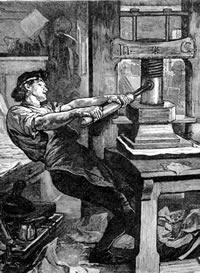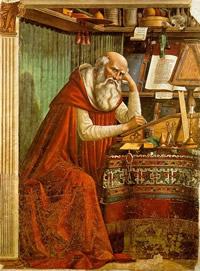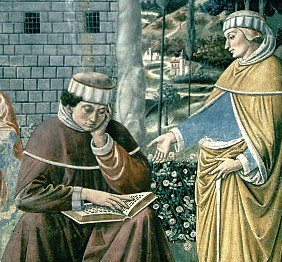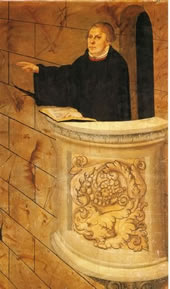"Take Up and Read:"
Ten Favorite Books from 2009
For Sunday January 10, 2010
Lectionary Readings (Revised Common Lectionary, Year C) hotlink: http://lectionary.library.vanderbilt.edu)
Isaiah 43:1–7
Psalm 29
Acts 8:14–17
Luke 3:15–17 (21–22)
If Catholic piety centers on the sacraments, and Eastern Orthodoxy privileges the aesthetics of icons and images, then Protestantism is a quintessentially book tradition. In The Illuminating Icon (1989), Anthony Ugolnik suggests that the conversion of Saint Augustine in 386 is a "primary epistemological model" for western believers. Augustine relates in his Confessions how he was converted when he heard the voice of a little child commanding him to "take up and read" the Bible, which was opened to Romans 13:13. Protestants, you might say, have been trying to read their way into heaven.
The English Puritan John Foxe believed that "God conducted the Reformation not by the sword, but by printing, writing, and reading." On the title page of his book Acts and Monuments (1563), later nicknamed Foxe's Book of Martyrs, Foxe depicted two congregations at worship—Catholics fingering their rosaries, and Protestants reading books in their laps.
 |
Printing press. |
The 16th-century Reformation that convulsed Europe spawned a text-oriented faith that denigrated images and deemphasized the sacraments. The reformers whittled Catholicism's seven sacraments down to two. A new piety arose in which private reading, unmediated by church clerics, usurped rituals and relics. In the early years of the Reformation, Protestant extremists smashed sculptures, defaced images, and whitewashed the frescoes of churches. "Images," sniffed the Genevan Reformer John Calvin, "cannot stand in the place of books."
The sermon upstaged the eucharist as the defining moment of the liturgy. Reformation sermons were delivered from an elevated pulpit, in street vernacular, and directed to a person's intellect, instead of in ritual formulas intoned in Latin which no one understood. Preachers like Huldrych Zwingli in Zurich and Martin Luther in Wittenberg preached their sermons wearing a radical change of dress, the scholar's gown as opposed to a monk's cowl, symbolizing this centrality of books, words, scholarship and ideas. These radical changes highlighted the inextricable link between ministry and scholarship for Protestants.
The Orthodox lay theologian Alexei Khomiakov thus complained that in Protestantism "a scholar has taken the place of the priest." The great Russian Orthodox theologian Sergei Bulgakov similarly described Protestantism as a "professorial" religion in which the central actor is the preacher-scholar in the library rather than the priest in the sanctuary. The best and first colleges and universities in America were in large part founded to educate a learned clergy (Harvard, Princeton, Yale, etc.).
 |
St Jerome. |
The invention of movable type, along with the production of paper from rags instead of animal skins or reed-based parchment, was the engine that drove the Reformation. They made book production cheaper, easier, and profitable. Luther, whose collected works run to some 60 volumes, is a case in point. Between 1517 and 1520 his pamphlets sold over 300,000 copies. His phenomenal capacity to write met the voracious appetite and enthusiasm of a newly literate reading public.
"There were 390 editions of various of Luther's writings published in Germany in 1523 alone," writes Diarmaid MacCulloch in his magisterial book The Reformation (2003), "and it has been calculated that beyond what he himself had written, around three million copies of related pamphlets (Flugschriften, or fly sheets, mostly illustrated) were printed in German by 1525. . . Print could take the Reformation to anyone who was prepared to hear a pamphlet being read out."
In books, pamphlets, sermons, and tracts the early Protestants encountered what MacCulloch calls "the explosive power of an idea" (namely, a restatement of St. Augustine's ideas about salvation). "Monarchs, priests, nuns, merchants, farmers, laborers were seized by ideas that tore through their experiences and memories and made them behave in new ways, sometimes admirable, sometimes monstrous."
Protestants then and now discover in books what the Psalmist for this week calls "the voice of the Lord." Sometimes the "voice of the Lord," the Psalmist writes, "thunders, breaks in pieces the cedars of Lebanon, strikes with flashes of lightening, shakes the desert, twists the oaks, and strips the forests bare" (Psalm 29). At other times "the voice of the Lord" we discover in books speaks softly and gently to encourage us. After his baptism by John Jesus heard a voice from heaven — the declaration of God the Father that Jesus was his beloved son.
 |
Augustine's conversion. |
With gratitude to those first reading Protestants, here are my "top ten" books for 2009. In each of them, in their own way, I encountered the bark-stripping power of ideas and the tender voice of the Lord.
Julian Barnes, Nothing to Be Frightened Of (New York: Alfred A. Knopf, 2008), 244pp. "I don't believe in God," writes the British atheist novelist in his memoir, "but I do miss him." Barnes explores the double entendre of his title.
Veronica Chater, Waiting for the Apocalypse; A Memoir of Faith and Family (New York: WW Norton, 2009), 330pp. A daughter recalls how the fanatical faith and deep love of her father inflicted horrible damage on the entire family.
Terry Eagleton, Reason, Faith, and Revolution; Reflections on the God Debate (New Haven: Yale, 2009), 185pp. A withering and witty polemic against the atheists Richard Dawkins and Chris Hitchens by Britain's leading literary critic.
Deborah Ellis, Children of War; Voices of Iraqi Refugees (Berkeley: Groundwood Books, 2009), 128pp. Twenty-three Iraqi children, ages 8 to 19, tell what it's like to experience war.
Philip L. Fradkin, Wallace Stegner and the American West (New York: Knopf, 2008), 369pp. Published to coincide with the centennial of Stegner's birth and written with the full cooperation of his only child, Fradkin considers Stegner as Talented Teacher, Reluctant Conservationist, and Prominent Author.
 |
Luther the scholar-preacher-writer. |
Daniel Jonah Goldhagen, Worse Than War; Genocide, Eliminationism, and the Ongoing Assault on Humanity (New York: PublicAffairs, 2009), 658pp. The controversial and award-winning author of Hitler's Willing Executioners (1996) examines how ordinary people "eliminated" 127-175 million fellow citizens in the last hundred years.
Brad Gooch, Flannery; A Life of Flannery O'Connor (New York: Little, Brown and Company, 2009), 448pp. The first biography of O'Connor since she died of lupus in 1964 explores the Catholic novelist who attended daily mass most of her adult life, and who described herself as "a thirteenth century Christian" and "hermit novelist."
Mary Gordon, Reading Jesus; A Writer's Encounter with the Gospels (New York: Pantheon Books, 2009), 205pp. An award-winning author and English professor at Barnard College explains how at the age of sixty she realized with "a clutch of anxiety and shame" that she had never read the Gospels from beginning to end. Her book is the result of that "disturbing and exhilarating enterprise."
Jeffrey Spier, editor, Picturing the Bible; The Earliest Christian Art (New Haven: Yale University Press in association with the Kimbell Art Museum, 2007), 309pp. This hefty coffee table book should be savored both for its scholarly texts and spectacular images (263 color and 40 black and white). The book was published in conjunction with an exhibition conceived and organized by Spier for the Kimbell Art Museum in Fort Worth, Texas.
Jeffrey Toobin, The Nine; Inside the Secret World of the Supreme Court (New York: Anchor Books, 2007), 452pp. Toobin garnered a dozen "book of the year" awards for his description of life, work, quirky personalities, and the power of partisan ideology inside the highest court of the land.
Diane Wilson, Holy Roller; Growing Up in the Church of Knock Down Drag Out; Or, How I Quit Loving a Blue-Eyed Jesus (White River Junction, Vermont: Chelsea Green Publishing, 2008), 210pp. A fourth-generation shrimper on the Texas gulf coast recalls her colorful family, a crazy-faith subculture, the hard life of shrimpers, crabbers, and oystermen, and a mysterious double homicide.
OK, that's eleven. At any rate, "take up and read" and listen for "the voice of the Lord."
Image credits: (1) personalpublisher.wordpress.com; (2) First Things; (3) Bible Research; and (4) Dr. Gordon A. Jensen, Lutheran Theological Seminary.





